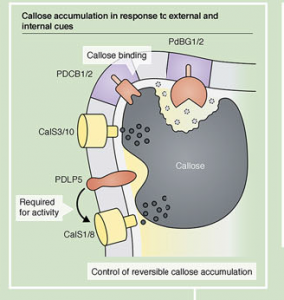Selected Recent Publications
Yan, D. et al. (2019). Sphingolipid biosynthesis modulates plasmodesmal ultrastructure and phloem unloading. Nature Plants 5:604–615.
Lee, J.-Y. and M. Frank (2018). Plasmodesmata in Phloem: Different gateways for different cargoes. Curr Opin Plant Biol 43:119-124.
Ross-Elliott, T.J. et. al. (2017). Phloem unloading in Arabidopsis roots is convective and regulated by the phloem-pole pericycle. eLife, (10.7554/eLife.24125).
Lim, G.-H., et al. (2016). Plasmodesmata localizing proteins regulate transport and signaling during systemic immunity. Cell Host & Microbe. 19:541–549.
Cui, W., and Lee, J.-Y. (2016). Arabidopsis callose synthases Cals1/8 regulate plasmodesmal permeability during stress. Nature Plants 2:16034 doi:10.1038/nplants. 2016.34.
Lee, J.-Y. (2015). Plasmodesmata: a signaling hub at the cellular boundary. Curr. Opin. Plant Biol. 27:133-140.
Sager, R. and Lee, J.-Y. (2014). Plasmodesmata in integrative cell signaling. J. Exp. Bot. 65:6337-6358.
Lee, J.-Y. (2014). New and old roles of plasmodesmata in immunity and parallels to tunneling nanotubes. Plant Sci. 221:13-20.
Wang, X., et al. (2013). Salicylic acid regulates cell-to-cell communication during innate immune responses in Arabidopsis. Plant Cell, 25:2315-2329.
Lee, J.-Y., et al. (2011). A Plasmodesmata-Localized Protein Mediates Crosstalk between Cell-to-Cell Communication and Innate Immunity in Arabidopsis. Plant Cell 23:3353-3373.
**************
For a complete list of publications, please visit:
https://scholar.google.com/citations?user=yCG9SjQAAAAJ&hl=en

Callose, a β-1,3-glucan polymer, appears to serve as both a structural and a regulatory element of plasmodesmata. It is synthesized by a callose synthase and degraded by a β-1,3-glucanase. The levels of callose deposits around plasmodesmata are not persistent but vary in response to internal and external signals or stresses, hence increasing or decreasing plasmodesmal permeability.
<Plasmodesmata at a Glance (Sager & Lee, 2018, JCS)>
![]()


